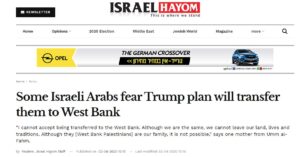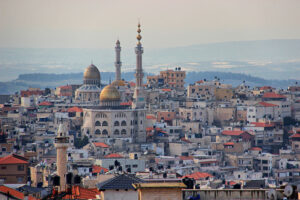- 1.3K
- 1.3KSHARES
UPDATE, 12:45 PM EST:
Reuters Arabic Corrects
In response to communication from CAMERA Arabic, editors corrected the erroneous reference to "Palestine" and language which had suggested that all of the Israeli Arabs living in the "Triangle" had been displaced in 1948. See below for a detailed update.
Israel Hayom Amends Headline (Feb. 6)
In response to communication from CAMERA, Israel Hayom amended its headline so that it no longer misleadingly refers to "transfer" of Israeli Arabs to the West Bank. See below for a detailed update.
A Reuters article earlier this week about Israeli Arab fears concerning President Trump's "Prosperity to Peace" plan wrongly suggested that residents of Arab towns in "The Triangle" region of northern Israel are in danger of being uprooted from their homes and land.
 Contrary to the Feb. 3 headline, "Arabs in Israeli border towns fear Trump plan will transfer them to West Bank," the plan does not propose removing residents from their homes in Israel and relocating them into the West Bank, a separate geographic area. Rather, it suggests transferring the towns, the residents together with their homes and land, from the State of Israel to the future State of Palestine. In other words, the plan calls for redrawing the map, and not transferring people from one place (Israel) to another (the West Bank). The proposal states: "The Vision contemplates the possibility, subject to agreement of the parties that the borders of Israel will be redrawn such that the Triangle Communities become part of the State of Palestine."
Contrary to the Feb. 3 headline, "Arabs in Israeli border towns fear Trump plan will transfer them to West Bank," the plan does not propose removing residents from their homes in Israel and relocating them into the West Bank, a separate geographic area. Rather, it suggests transferring the towns, the residents together with their homes and land, from the State of Israel to the future State of Palestine. In other words, the plan calls for redrawing the map, and not transferring people from one place (Israel) to another (the West Bank). The proposal states: "The Vision contemplates the possibility, subject to agreement of the parties that the borders of Israel will be redrawn such that the Triangle Communities become part of the State of Palestine."I cannot accept being transferred to the West Bank. Although we [Israeli Arabs and Palestinians] are the same, we cannot leave our land, lives and traditions.
Reuters' Arabic version of the same article carried the identical problematic headline, and also contained additional inaccuracies.
Contrary to Reuters' standards, the Arabic version refers to "flags of Palestine," instead of "Palestinian flags."
Also, in a second problematic difference between the two languages,the Arabic version errs:
Most of the Arabs of Israel […] are the descendants of the Palestinians who remained in their homeland but were internally displaced after the 1948 war (Emphasis added. Translations by CAMERA Arabic.)
The English report, in contrast, accurately states:
Israel’s Arabs [...] are mostly the descendants of the Palestinians who remained in their homes or were internally displaced following the 1948 war that surrounded Israel’s creation." (Emphasis added.)
The Arabic is inaccurate because the vast majority of Arabs in Israel after the 1948 war remained in their homes, and were not internally displaced; a generous estimation refers to about a quarter of the entire population that remained in Israel after the war as "displaced."
The Arabic formulation altogether omits the majority, who were in fact not displaced, and remained in their homes.
 Israel Hayom published an article largely derived from the Reuters story, but with its own edits ("Some Israeli Arabs fear Trump plan will transfer them to West Bank"). The subheadline features the misleading quote from an Umm al-Fahm resident:
Israel Hayom published an article largely derived from the Reuters story, but with its own edits ("Some Israeli Arabs fear Trump plan will transfer them to West Bank"). The subheadline features the misleading quote from an Umm al-Fahm resident:
I cannot accept being transferred to the West Bank. Although we are the same, we cannot leave our land, lives and traditions . . .
Update, 12:45 EST: Reuters Corrects Arabic Report
In response to communication from CAMERA Arabic, editors commendably replaced the reference to "flags of Palestine" to "Palestinian flags." In addition, editors commendably the inaccurate description of Israeli Arabs as "mostly descendants of the Palestinians who remained in their homeland but were internally displaced after the 1948 war." The corrected article now accurately describes Israeli Arabs as "mostly descendants of the Palestinians who remained in their homes or were internally displaced after the 1948 war."
Update, Feb. 6: Israel Hayom Amends Its Headline
In response to communication from CAMERA, Israel Hayom commendably amended its headline so that it no longer misleadingly refers to Israeli Arabs fears of "transfer" to the West Bank. The improved headline states: "Some Israeli Arabs fear Trump plan will put them under PA control."

